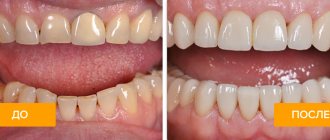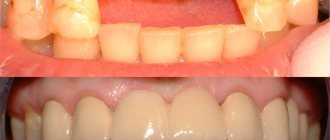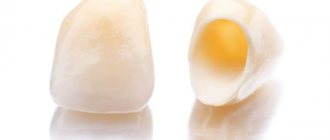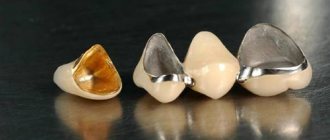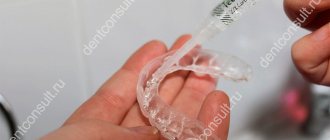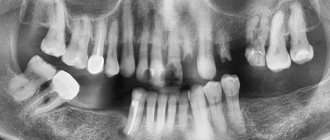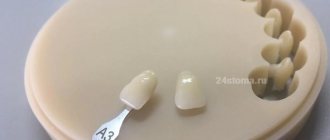Modern dentistry can offer different types of orthopedic structures, including metal-ceramic crowns, for successful reconstruction of lost teeth. We will discuss the features of metal-ceramic crowns in detail below: we will consider their structure, stages of production and installation, advantages and disadvantages, and the cost of metal-ceramic crowns for teeth.
Calculate the cost of treatment by taking a short test in 20 seconds!
Do not delay your treatment, because in this matter time plays against us.
General information and unique features
Metal-ceramic crowns are one of the most popular types of orthodontic structures among dental patients. The increased demand for this particular type of orthopedic products is explained by their durability, high aesthetics and impeccable positive results in the restoration of lost teeth. The price of metal-ceramic crowns is an order of magnitude higher than that of crowns made of metal alloys, but at the same time they are more affordable than designs made of expensive dental porcelain.
Metal-ceramic crowns have a special design: inside there is a strong frame base made of metal alloy, which is covered on the outside with a dental porcelain finish. The finish is applied to the frame base of the crown in layers: and each layer of applied material undergoes heat treatment in a specialized oven at elevated temperatures.
Layer-by-layer application and subsequent heat treatment provide super-strong adhesion between the metal base and the ceramic composition applied to it. Below we post a photo of a metal-ceramic crown; after studying it, you can see exactly what it looks like.
Further in the material, we will thoroughly understand the advantages and disadvantages of metal-ceramic crowns, and also find out why there is a fairly large price range in dental clinics for the cost of metal-ceramic crowns with work, and we will explain in detail why in this case the lowest price offer is not the most profitable, on the contrary, it can significantly increase costs.
Manufacturing process
Patients who want to install truly high-quality metal-ceramic dentures should understand that this will not be possible quickly. It will take at least 10-14 days to produce them. The procedure for making crowns is as follows:
- The doctor applies a special mixture to the already ground teeth, which hardens almost instantly. After removing it, the dentist takes an impression;
- if the impression is made successfully, then it serves as the basis for creating a plaster model of the tooth being restored;
- Next, a model of a metal frame made of wax is developed. The finished model is transferred to a dental prosthetic workshop for the manufacture of a prosthesis from an alloy agreed with the patient;
- When the frame is completed, fitting is required. It is put on the patient’s teeth and if all is well, it is returned to the technicians;
- in the workshop, a ceramic composition is applied to the frame in two layers and sent to a specialized oven for heat treatment;
- then enamel is applied to the product, corresponding to the shade of the patient’s natural tooth covering;
- The orthopedist performs a control fitting. When the crown fits snugly and meets all the requirements, it is sent to the workshop again. There, a special glaze is applied to the prosthesis to add shine and the final firing is performed.
Only after all the above steps are the crowns considered ready for installation. If some specialists offer you shorter terms for making crowns, then this is a serious reason to doubt the quality of the products and the professionalism of the doctors themselves.
Points to consider
If you definitely decide to install a metal-ceramic crown, then you should definitely take into account that different types of metal-ceramic products differ not only in price, but also in service life, aesthetic indicators, reliability and strength characteristics. We will tell you more about the types of metal-ceramic crowns below, but for now we will make one more important note: when planning to install a metal-ceramic crown in dentistry, it is extremely important to choose the right clinic to receive this service. Even the most expensive and well-made metal-ceramic crown will not last long if:
- The dental units were poorly prepared and ground for the installation of a metal-ceramic crown;
- When taking impressions for its manufacture, the specialist made a mistake.
Preparatory procedures for installing a metal-ceramic crown always begin with sanitation of the oral cavity and treatment of all diseases of the teeth and oral cavity identified during the examination. If the root canals of the tooth are treated incorrectly, errors are made in their filling - in the future there is a high risk of an inflammatory process occurring in them. The occurrence of inflammation can lead to the fact that the prosthesis will have to be removed, treated, and then all restoration manipulations will have to be carried out from the very beginning.
To prevent such negative consequences, the doctor must refer you for a control X-ray examination after therapeutic and other manipulations: pulp removal, canal filling.
No less important are the quality of grinding teeth for crowns and the accuracy when taking impressions. If the doctor makes a mistake at this stage of treatment or uses an inexpensive material that cannot accurately convey all the individual characteristics of the teeth, the finished crown will not adhere to their surfaces with the required degree of density. Saliva will constantly flow under it, and pathogenic microorganisms will enter, provoking the development of caries and decay in dental tissues.
For these reasons, it is recommended that before starting treatment and installing metal-ceramic crowns, make sure that you turn to professionals. Dental prosthetic services of European quality level are provided in our dental clinic in Moscow - Vanstom. If you want to find out the cost of a metal-ceramic crown, get professional advice on prosthetics from an experienced and competent specialist - come to our Vanstom dentistry! We are located in the center of Moscow, our exact address: Moscow, Baumanskaya metro station, st. Bakuninskaya, 17/28.
Indications for installation of metal ceramics
Dentists install crowns and bridges made of metal-ceramics in case of functional, anatomical or aesthetic inferiority of natural teeth.
The main indications for use include:
- destruction of natural crowns due to carious processes or traumatic factors, in which restoration with inlays or fillings is impossible;
- increased abrasion of tooth enamel;
- abnormalities in the development or incorrect position of the front teeth and other methods do not provide the desired effect in eliminating such anomalies;
- wedge-shaped defects of teeth in the smile area and fluorosis;
- changes in the color of tooth enamel and the inability to achieve whiteness using whitening technologies;
- absence of one or more units in the dentition;
- inconsistency of existing orthopedic structures in terms of functionality and aesthetics.
In some cases, metal-ceramic products are used for mild and moderate periodontitis as splinting structures.
Types of metal-ceramic crowns
In Moscow dentistry, metal-ceramic crowns for restoring lost or severely damaged teeth can be offered in three main types:
- Traditional crowns;
- Products from precious metal alloys;
- Crowns made using specialized milling equipment.
The price of metal-ceramic dental crowns will largely depend on their type, and therefore you should familiarize yourself with the features of each type in advance. Let's look at the characteristics of different types of metal-ceramic crowns below.
Life time
The service life of metal-ceramic crowns ranges from 10 to 12 years. If the ceramic layer is chipped as a result of mechanical stress, it can always be restored with the help of a dentist. When the service life of the crowns comes to an end, they are replaced with new ones.
It is important to see a doctor immediately if you experience pain in your teeth under a bridge or crown. Dentures do not protect against the development of secondary caries, especially if the timing of crown replacement is missed.
Traditional metal-ceramic crowns
For classic metal-ceramic crowns, prices in Moscow are offered at relatively affordable prices, since alloys from available metals - cobalt, chromium - are used to create the frame base. The frame part turns out to be quite strong, but there is one significant nuance: it is not completely processed with ceramic mass; without a layer of ceramics, a small ledge remains in the area of contact of the prosthesis with the gum. This entails contact of the metal surface with soft tissues, which is why the gums take on a distinct, unsightly bluish tint.
You can avoid this negative phenomenon by ordering the production of a metal-ceramic crown with shoulder mass. In this type of crown, the ledge is also covered with ceramic, like the rest of the frame, but its production will cost more.
Caring for metal ceramics
To increase the life of the prostheses, some care must be taken immediately after completion of the prosthetics. Since gums may remain sensitive for some time, dentists recommend using a soft-bristled brush and appropriate toothpastes. Over time, you will begin to take care of your teeth as before. When worn Use mouth rinses after meals. Despite the fact that the coating is highly durable, you should definitely not chew nuts or open bottles with your teeth. Following the dentist’s recommendations will ensure the durability and aesthetics of artificial crowns.
Dentures help protect the tooth as a whole, but it does not prevent the development of caries or gum disease.
Crowns with a frame base made of precious metals
The frame part of a metal-ceramic crown may be made from alloys of precious metals. The cost of a metal-ceramic crown in Moscow in this version will depend on the weight of the precious metal, as well as on its type and, naturally, will be higher than the price of a product with a cobalt-chrome frame. The advantage of this type of crown is their increased strength and more aesthetic appearance.
Indications and contraindications
Metal-ceramic crowns are used for:
- Restoring the shape, function and color of teeth damaged by caries, trauma, fluorosis, taking medications, etc.
- Increased abrasion of enamel;
- Correction of dental anomalies that cannot be straightened using orthodontic methods;
- Elimination of both single dental defects and 2-3 adjacent teeth;
- Supports for removable dentures.
The installation of metal-ceramics is excluded in case of defects in the crown of the abutment tooth (if it is thin-walled, low, etc.), severe form of periodontitis, with large defects in the row (if more than 4 teeth are missing), if the tooth has living pulp.
Crowns using computer technology
When producing a metal-ceramic crown of this type, its frame part is not cast from molten metal, but is produced on specialized milling equipment using an innovative CAD/CAM program. The use of this technology in the production of crowns makes it possible to produce a prosthesis that is ideally suited for a specific clinical case and has the highest possible degree of adherence to the dental surfaces, and this has a positive effect on both the strength of the crown itself and the aesthetics of the restoration as a whole.
For such metal-ceramic crowns and teeth, the price in Moscow starts from 20,000 rubles. What will determine the price of a metal-ceramic crown, what factors are involved and whether it is worth saving on the service by choosing cheap products - we will look at these pressing issues in detail in the next section of the article.
Stages
After preparing the surface, the orthopedist makes an impression of the jaws, from which a crown is stamped or cast in the laboratory. Manufacturing takes several days. Before installing the structure, they carry out fittings - check how it fits and whether there are any defects. The crown may be too wide, narrow, or high. Fitting helps to notice shortcomings and eliminate them.
The restoration is first placed with temporary cement. The patient is given the opportunity to get used to a foreign object in the mouth, to understand whether the height is disturbing or whether the edge is cutting the gum. Only after this the structure is installed on permanent cement.
- Before fixation, the crown is treated with a special solution, degreased and dried.
- Next, the tooth is treated with an antiseptic, and the remaining moisture is removed with ether or air. In some cases, gum retraction is performed with a thread to clearly mark the junction of the artificial crown and hard tissue.
- The components for cement are mixed on a sterile plate.
- A thin layer of cement is placed inside the restoration and placed over the tooth.
- Excess is removed. The patient is asked to sit with his teeth closed. Then clean the surfaces again and rinse your mouth with a special solution. This completes the orthopedist’s work.
Cobalt-chrome crowns
Making a metal-ceramic crown from a cobalt-chrome alloy will be cheaper than making an analogue from precious metal or with a milled frame. If high-quality materials from German manufacturers are used for production, the average cost of a crown can be from 11,500 rubles. This price is relevant for prostheses without shoulder mass; products with this element will cost more - from 15,000 rubles.
However, you can see advertisements in which the price of a crown is much lower - from 5,000 rubles. You should not be tempted by the cheapness of the service, since the production of such inexpensive crowns uses low-quality materials and therefore the savings in fact are very doubtful. A frame made from cheap materials can break, and the ceramic layer can constantly chip off.
What to do after the procedure
The time during which you cannot eat after a crown is installed depends on the type of cement. In addition, anesthesia is still in effect, and you can accidentally injure yourself. It is better to refrain from eating for 2-3 hours.
It is not recommended to load the side where the crown was installed - chew on the opposite side. Drinks and food with coloring pigments (red wine, berries, seasonings) should be kept to a minimum. It is recommended to avoid:
- sudden temperature changes (for example, drinking ice cream with coffee);
- solid food (bones, cartilage, nuts);
- sticky foods (taffy, some oriental sweets).
Hygiene requirements are standard: cleaning the mouth in the morning and evening. Superfloss, dental brush, and irrigator are recommended for bridges.
Crowns made of an alloy of gold and platinum (palladium)
Reviews about metal-ceramic crowns are mostly positive, but the production of such a prosthesis will cost you no less than 15,950 rubles. This figure will take into account not only the basic materials, but also the price of gold and other precious metals that will be used to obtain the alloy for the production of the crown base.
It will cost you the most to make crowns using the CAD/CAM system, but their high price is fully justified by the long service life of metal-ceramic crowns and high aesthetic performance. However, the final price of the crown may also include additional costs, including:
- 1. Production of temporary crowns from plastic and other types of polymers. It is impossible to do without the production of a temporary prosthesis made of plastic if the restoration is performed in the smile area.
- 2. Installation of a turnkey metal-ceramic crown involves preliminary treatment of the teeth, which is calculated separately and included in the final cost of the service.
Prices for metal-ceramic crowns seem high, but they are an order of magnitude lower than the cost of reconstruction with metal-free ceramic products and veneers. Moreover, the cost of the procedure will be paid off by the high quality and durability of the restoration result. How to choose the best metal-ceramic crowns without making a mistake with either price or quality - you can always ask Vanstom specialists this question! To make an initial appointment, just dial our contact phone number! Or come to our clinic at the address: Moscow, Baumanskaya metro station, st. Bakuninskaya, 17/28.
Ceramic coating
The metal frame of the orthopedic structure is covered with a layer of dental ceramics, which in composition is almost similar to household ceramics, however, the compositions for lining metal-ceramic crowns contain an increased content of components such as albite and orthoclase, which increase the strength of the created layer.
The ceramics are applied to the frame in layers and specialists use a special tool for this work. After applying the next layer, the structure is fired in a vacuum oven. This is necessary to ensure the strongest possible adhesion of the ceramic layer to the frame.
Reviews of metal-ceramic crowns from patients indicate that this type of dental orthopedic structures is not only strong and durable, but also highly aesthetic, which makes it possible to regain an attractive and natural smile!
Review of advantages and disadvantages
Metal-ceramic crowns have both advantages and disadvantages, which you should familiarize yourself with as carefully and in detail as possible in order to make the right decision for yourself. Let's start with a quick overview of the pros.
- High-quality made and installed metal-ceramic crowns are distinguished by solid strength and durability. Their average service life is up to 15 years and at the same time they do not lose either their useful functionality or aesthetics.
- It is almost impossible to visually distinguish the finishing coating of crowns from natural teeth, which makes it possible to install metal-ceramic crowns on the front teeth included in the smile zone.
- When making a prosthesis, they can make you a metal-ceramic crown of the required color shade, which will match the tone of the natural enamel coating.
The outer ceramic layer of the prosthesis has a smooth and pore-free surface, and thanks to this, pathogenic microorganisms do not accumulate on its surface and deposits do not form. Crowns are quite easy to care for and, of course, among the advantages of the products it is worth mentioning the optimal balance between their cost and quality.
However, it is worth considering that metal-ceramic crowns also have disadvantages, to which experts include the following important features:
1. Metal-ceramic crowns cannot be used if a person has an allergic reaction to metals and their alloys. Moreover, if a person already has metal dentures in the oral cavity, then installing a crown made of a different alloy can provoke a galvanic effect - a phenomenon that causes an unpleasant metallic taste in the mouth, and also provokes a number of soft tissue diseases.
2. When installed on the front teeth, a metal-ceramic crown may not provide the required aesthetics, which is especially important if a person has naturally thin and transparent enamel. The restored unit will stand out noticeably against the natural teeth. Therefore, when carrying out restorative manipulations in the smile area, dentists advise using other types of orthopedic products - for example, metal-free crowns. If you need to restore chewing teeth, then metal-ceramics will be one of the best options, even if the crown is made without a shoulder element.
3. Possible change in the color of soft tissues and the appearance of a dark stripe at the edge of the prosthesis. These problems arise if standard metal-ceramic crowns without shoulder mass are chosen for reconstruction. The gum acquires a bluish tint due to the fact that the edge of the installed crown, which is not covered with a layer of ceramics, is closely adjacent to it. This is especially critical if restorative procedures are carried out in the frontal area and where the gums are clearly visible when smiling.
The appearance of a dark line in the restoration area is explained by the gradual descent of the gums downwards, as a result of which the metal not covered with ceramics will be visible. If you want to avoid such problems, you should initially order crowns with a shoulder element. They are more expensive than standard options, but at the same time they do not have areas without a ceramic coating and therefore their aesthetic indicator is much higher.
Dentists recognize that a significant disadvantage of metal-ceramic crowns is the need for grinding of teeth, during which a fairly large amount of natural tissue is ground off from the tooth. Teeth are treated over their entire surface, from the inside and outside, and the tissue is removed to a depth of two millimeters. Removing such a significant amount of natural tissue negatively affects the health of the tooth, making it more fragile and vulnerable to the action of harmful bacteria.
One of the disadvantages of metal-ceramic crowns is definitely the need that arises in some circumstances for preliminary depulpation of the tooth. This decision is made by the doctor in cases where the volume of tissue removed during grinding will be maximum: when a significant amount of dentin is removed, the risks of pulp burns and nerve death during further manipulations increase significantly.
Usually, teeth located in the smile zone are depulped, since they have less dentin thickness, but chewing teeth are preferably not depulped and left with a living nerve. You can get detailed advice about all the features of metal-ceramic crowns at an appointment with a specialist from our dentistry in Moscow - Vanstom!
Factors for choosing a fixation method
The choice of the best fixation method for the patient is made by the doctor, based on their clinical picture, the main determining factors are:
- The total cost of treatment, the possible quality of the result and the financial requirements of the patient;
- Occlusal initial parameters;
- Potential risks of complications;
- Aesthetic requirements;
- Availability of access to the intervention area;
- Implant position;
- The need to maintain the structural elements of the prosthesis;
- Safety for the patient.
Based on the explanations of the attending physician, the patient consciously chooses or refuses to use this method.
It is preferable (ideally) to use screw fixation when installing implants in the lateral jaw, when the exit of the screw shaft is located in the center of the chewing surface. In the anterior part of the upper jaw, in cases where the implants have a vestibular inclination, the doctor determines based on the clinical situation which fixation is more convenient to use - cement fixation on individual abutments or using transocclusal screws.
The main stages of dental prosthetics with metal-ceramic crowns
Reconstruction of lost or severely damaged teeth with metal-ceramic crowns is relatively quick. Even taking into account preliminary therapy and high-quality sanitation of the oral cavity, the installation of turnkey crowns will take no more than 2 weeks. Attention! If the clinic promises to make crowns in less time, then this is a serious reason to be wary, since a high-quality prosthesis cannot be made in a couple of days.
What is a crown and when is it installed?
A crown is a single dental prosthesis that completely replicates the visible part of the tooth. This differs from an inlay or veneer, which imitate only a fragment of a tooth. Installation of a crown is required in case of significant damage to the tooth (30% or more), when classical filling is unable to ensure proper functionality of the dental unit. A crown is also placed when a tooth is lost. In this case, the support for the prosthesis is provided by neighboring teeth or an implant that replaces the root of the lost tooth. Depending on the design features, the method of attaching the crown is selected.
Restorative procedures involving the installation of metal-ceramic crowns are divided into the following stages
Preparatory stage.
The patient comes to the clinic and undergoes an examination in the dentist's office. An X-ray examination is required, which can show whether there is inflammation in the area of the tooth, which will later be restored with a metal-ceramic crown. If symptoms of inflammation are present, then you will need to treat the tooth by carefully treating and filling the canals. If the tooth canals have been treated previously, then the quality of their filling will certainly be checked.
If the examination reveals that the patient has caries or other dental diseases, worn out old fillings, all this must be eliminated before the teeth are turned and prepared for a metal crown. The installation of a metal crown does not always require preparation (removal of the pulp and nerve), mainly in cases of restoration of anterior teeth and with one root, but dentists prefer not to subject chewing teeth to this procedure without clear indications.
A tooth in which more than 50% of the crown is destroyed is restored: for this, a pin is screwed into the canal, after which the coronal part of the unit is built up with a filling composite. Installing a pin allows you to give the filling the required degree of strength necessary for the restored crown to be able to withstand the stress of chewing food.
But there are cases when the tooth is left with extremely thin walls, or even just one root. In this case, before restoring the unit with a metal-ceramic crown, a special inlay is installed in the tooth. The metal-ceramic crown is firmly fixed to it, and the inlay helps protect the prosthesis from breaking under load.
Prosthetics stage
After all the preparatory procedures are completed, teeth grinding begins. The unit on which the crown will be installed is ground on all sides to the thickness of the future prosthesis. After this is done, an impression is taken from the teeth, which is sent to the laboratory, where a dental technician will use it to make a metal-ceramic crown.
While the metal-ceramic crown is being made, the patient is offered a temporary prosthesis. Plastic structures are especially relevant for prosthetics in the smile area - they will help maintain its aesthetics. In addition, the temporary crown will protect the ground teeth from the negative effects of external factors.
An important point: it is worth knowing that the cost of preparing each tooth for installation of a prosthesis can range from 4,000 to 10,000 rubles, and therefore sometimes it may be more profitable to install a metal-ceramic crown on an implant. This is especially true for cases where only one tooth needs to be restored. In such circumstances, a metal-ceramic crown on an implant will not only reduce the cost of prosthetics, but also will not require grinding of adjacent supporting and healthy teeth.
Free consultation on the cost of treatment in our dentistry
Leave a request and the clinic administrator will contact you within 15 minutes!
Preparatory stage:
1. The patient comes for examination to a specialist. After assessing the condition of the tooth and a series of studies, the dentist makes a decision on the prosthetic technique.
2. If the root part of the tooth is alive, then it is possible to carry out a series of therapeutic manipulations, during which the specialist eliminates all inflammatory and destructive processes, if necessary, the dental canals are re-filled and a pin is applied.
If the tooth root is significantly weakened, then the pin cannot be used, and in this case, before installing a metal-ceramic crown, the specialist uses a stump spacer, designed to replace bone tissue that has undergone the process of destruction.
3. If the root of a tooth is missing or severely damaged, a dental implant must be installed. A metal-ceramic crown on an implant will cost more than other options, but this type of prosthesis has maximum durability and strength and is visually indistinguishable from natural teeth.
After all clinical training activities are completed, the second stage of prosthetics begins - laboratory.
Laboratory stage of installation of metal-ceramic crowns:
During the laboratory stage of prosthetics with metal-ceramic crowns, the structure itself is manufactured. The process consists of the following stages:
- Taking impressions of the patient’s teeth;
- Modeling of the structure frame;
- Trying on the finished prosthesis;
- Correction of possible defects.
The process ends with the installation and fixation of a metal-ceramic crown.
Which is better: zirconium or metal-ceramic crowns?
The question of which crowns are better—metal-ceramic or zirconium dioxide—patients often ask dentists during consultations on prosthetics. This question can be answered this way: in terms of aesthetics, zirconium dentures are better than metal-ceramic crowns. However, if your natural enamel has a high degree of transparency, zirconium will not be the best material for the production of a prosthesis.
The zirconium dioxide frame is bright white and lacks transparency, and therefore the finished crowns will look unnatural against the background of other teeth in the row. If the enamel is highly transparent, it is best to give preference to crowns made from a separate type of dental porcelain - lithium disilicate.
If teeth restoration needs to be carried out in the area of chewing units, then zirconium crowns will be a good option, but there is one caveat - possible frequent chipping of the ceramic layer from the base of the frame. It is especially not recommended to install zirconium crowns on chewing teeth with an abnormal bite. In case of bite defects, the solution may be to install either metal-ceramic crowns or zirconium prostheses, but without applying layers of porcelain.
For prosthetics on the lateral chewing units, which experience maximum load when eating and chewing food, the best option may be duceram metal-ceramic crowns, produced by a German dental brand. The design of metal-ceramic crowns of this brand is unique - the proportion of ceramics in it is several times higher than the metal content and this not only has a positive effect on the strength of the prosthesis as a whole, but also significantly improves the aesthetics of the finished crowns.
Installing duceram metal-ceramic crowns will not be cheap - about 10,000 rubles per tooth, but the cost of prosthetics with this type of structure will be fully compensated by their durability and high quality. This type of metal-ceramic crowns cannot be recommended for prosthetics in the area of the front teeth; the difference between the prosthesis and natural teeth may be noticeable.
What specific type of crowns for prosthetics will be optimal in your case - this question is best discussed with the specialists of our dentistry in Moscow - Vanstom! To make an appointment at our clinic, just dial the contact phone number!
Calculate the cost of treatment by taking a short test in 20 seconds!
Do not delay your treatment, because in this matter time plays against us.
Installation on the front teeth
When creating crowns, dental technicians pay attention to the aesthetics of the structure, since the front teeth are not only involved in chewing food, but also enter the smile zone. Therefore, when restoring the anterior dentition, dentists take into account the following:
- Crowns should be parallel to eye level;
- The gap between the central incisors should be strictly in the center of the face;
- The units on the right and left should be symmetrical and similar in shape.
Microprostheses on the front teeth are more susceptible to chipping due to the thin cutting edge. To eliminate this risk factor, dentists carefully check the bite using articulation paper.
Service life of crowns, reviews
If you look for information about metal-ceramic crowns on websites on the Internet, you may notice that people often write negative reviews about this type of orthodontic products. But it is not the designs themselves that are to blame for this, but the poor quality of their manufacture, the incorrect preparation of the process of preparing for prosthetics with metal-ceramic crowns and its main stages. Below we will consider all the problems that may arise due to low quality of service.
1. Low aesthetics. After installing the crown in place, many people begin to complain that it stands out noticeably against the background of natural teeth. To prevent this from happening to you, the aesthetics of the crown must be assessed at the stage of trying it on, and if you are not satisfied with something, do not remain silent, but directly voice your complaints to the specialist leading your treatment.
2. Discomfort in everyday use. It can also be detected at the fitting stage. The crown may not fit tightly onto the prepared unit, or the patient will notice that he cannot close his jaw normally because the denture is too high. Such defects indicate that an impression was taken incorrectly and inaccurately from the ground teeth. There is only one solution to the situation - insist that the crown be redone for you. If the doctor offers you to correct the problem by cutting it down with a drill, this will indicate his incompetence and low level of professionalism, since such manipulations negatively affect the strength of the structure.
Remember, the crown should not prevent you from closing your teeth or speaking, and in addition, it is important that it fits tightly to the tooth surfaces, since the presence of even a small gap is a risk of developing various dental pathologies.
3. After installing the crown, pain appeared. Such symptoms may indicate that the root canal filling was performed poorly, which led to the onset of an inflammatory process in the upper part of the tooth root and the formation of suppuration in the indicated area - granulomas and cysts. If inflammation begins to develop, the patient may experience not only pain, but also swelling of the gums. There is only one way to correct the situation - removing the crown and refilling the canals.
4. The crown is broken. The fracture of a metal-ceramic crown is a consequence of improper preparation for the restoration process. For example, a unit was restored with a pin, but its walls were so thin that the pin element could not support the prosthesis. In this situation, prosthetics will have to be carried out again and the crown will have to be placed not on a pin, but on a stump tab, which will allow the prosthesis to be fixed in the oral cavity as firmly as possible.
Another problem that may arise is chipping of the outer ceramic coating. Typically, this phenomenon is observed when patients have abnormal contact to a small extent between the upper and lower dentition. To prevent the process of chipping the ceramic finish from the metal frame base, it is necessary to grind the surface of the teeth.
Also, chips of the porcelain layer can be caused by: the initial use of low-quality ceramic mass, errors in the layer-by-layer application of ceramics, firing technologies, or the patient’s violation of the doctor’s recommendations for the daily use of a metal-ceramic crown. It is quite possible to restore chips without removing the structure, but this again involves financial costs for the patient.
To avoid all the problems discussed that may arise due to poor-quality prosthetics with metal-ceramic crowns, we advise you to follow the following simple rules:
1. Do not choose a clinic for prosthetic services with metal-ceramic crowns, focusing solely on the attractive low price for prosthetics. It is important to understand that high-quality dental services simply cannot be cheap!
2. Don’t be afraid to have an active dialogue with the doctor leading your treatment and always express your complaints directly if you are dissatisfied with the appearance of the metal-ceramic crown made for you, you are uncomfortable using it, or you are bothered by unpleasant discomfort after prosthetics.
Separately, it is worth mentioning the service life of metal-ceramic crowns. Traditionally, installed products are given a one-year warranty after the prosthetic service, and the useful life of a high-quality prosthesis is at least 10 years. But in order for the crown to serve you for such a long time, it is important not only the quality of its manufacture, it is important that all stages of crown installation take place without violations of technology or errors. And to do this, you should apply for services to dentistry with an impeccable reputation, a staff of qualified and experienced personnel, and the availability of modern equipment and materials for prosthetics and dental treatment in the clinic.
The right approach to choosing dentistry for prosthetics with metal-ceramic crowns and to treatment in general is the guarantee that you will not waste either your time or your money. Come to Vanstom in Moscow and receive dental services of European quality!
How long does cermet last?
Dental crowns made from metal ceramics are quite durable. On average, the service life of products is at least 10-12 years. But patients who choose this type of prosthetics need to know that the service life directly depends on several factors:
- correct preparation of teeth for prosthetics. If the canals are filled with poor quality, inflammatory processes soon occur, the gums become swollen, and the patient feels severe pain. As a result, the dentures have to be removed, the tooth must be treated, and the denture must be made in a new way;
- orthopedic professionalism. It is very important that the doctor performs the grinding of hard tissues flawlessly. If irregularities and tubercles remain on the tooth, then the prosthesis will not fit tightly to the tooth tissue. Food, saliva and air enter the resulting gaps and very soon carious processes occur in such cases;
- experience and technical skill. It determines how closely the prosthesis matches the shape and shade of natural teeth.
By seeking prosthetic services at the Beryozka clinic in Balashikha, you can be sure that all stages will be performed flawlessly and you will receive a guarantee on the installed crowns.
Types of alloys in metal ceramics
Gold-platinum alloy
The classic version with which orthopedic dentistry began. The first crowns were made from gold at the end of the 19th century.
Nowadays, many materials have appeared that, along with solving the problem of restoring chewing function, are quite durable and at the same time meet high aesthetic and cosmetic requirements. But gold, as a material for the manufacture of frames for metal-ceramic prostheses, is still relevant today.
Only a noble alloy can adhere so precisely to the treated tooth, which practically eliminates disintegration and recurrent caries. Gold almost never causes allergies.
The disadvantage of using a gold alloy is the limitation on the length of the intermediate (located between two supports) part of the metal-ceramic bridge (in the manufacture of metal-ceramic bridges), as well as the price: the cost of such a crown is from 10,000 rubles.
Sometimes, to improve color rendition, on a metal frame cast from other metals. a thin layer of gold is applied, which illuminates through a layer of ceramic mass with a warm yellowish color.
Nickel alloy
Most often, nickel-based alloys are used to cast the frame, which is the most accessible of the metals that can be the basis for metal-ceramics. With nickel alloys there are no problems when casting and fitting in the patient's mouth.
However, despite all the advantages, nickel has a serious drawback. This metal is a strong allergen.
Our body's daily need for nickel is thousandths of a gram, and the production of one metal-ceramic crown requires 2 grams of an alloy containing 1.3 grams of nickel. Thus, the metal is in contact around the clock with the oral mucosa, tooth tissues, and jaw. The result is allergic reactions and weakened immunity.
In Germany, they abandoned the use of nickel in dental prosthetics 10 years ago (as well as stainless steel back in the 30s).
If you have a problem similar to that described in this article, be sure to contact our specialists. Don't diagnose yourself!
Why you should call us now:
- We will answer all your questions in 3 minutes
- Free consultation
- The average work experience of doctors is 12 years
- Convenient location of clinics
Single contact phone number: +7
Make an appointment
Cobalt-chromium alloys
The most optimal option taking into account biocompatibility and cost.
In cost, they are only 1.6 times more expensive than allergenic nickel alloys. The biocompatibility of the cobalt alloy is 36% (for the gold-platinum alloy it is 42%, and only one’s own teeth are 100% biocompatible), they are non-toxic and do not cause allergic reactions. Cobalt alloys are durable, and metal-ceramic bridges of fairly long length can be made from them.
Chromium alloys are not dangerous; only some of its salts are poisonous, but they cannot form in the oral cavity.
Molybdenum
A non-toxic metal, it is added to dental alloys in very small quantities to improve casting properties.
Beryllium
This metal is a carcinogen. It causes granuloma (a type of malignant tumor) in the lungs, liver, spleen and heart. Upon contact with beryllium, skin diseases develop and a severe weakening of the immune system is observed. In Russia, its use in dental alloys is prohibited.
Technological aspects of metal ceramics
In the process of manufacturing metal-ceramic structures, there are a number of key points that deserve special attention.
Tooth preparation for metal ceramics.
- The tooth must be prepared (ground) with a ledge at the gum level.
- The total thickness of the metal frame and the ceramic mass covering it is about 1.5 mm. As a result, if the tooth is ground without a ledge, we get the edge of the crown hanging over the gum and pressing on it. The crown presses against the blood vessels and a “bruise” forms. The metal frame comes into direct contact with the gum, and metal ions cause it to darken.
- In the case of preparation with a shoulder, the edge of the metal-ceramic crown rests on the hard tissues of the tooth without injuring the mucous membrane. This technology is quite labor-intensive, and its implementation requires a modern dental unit and, of course, the qualifications of a doctor and dental technician.
The intermediate part of the metal-ceramic bridge prosthesis should also not put pressure on the mucous membrane (gum), otherwise bedsores may form. Of course, in those places where it is visible, you have to make a compromise, but in any case the touch should be very gentle. And if food gets into a place where there is a loose seal, it will be much easier to remove it from there than in the case of the “full contact” option.
Many doctors “sin” by depulping (removing the nerve of the tooth) even healthy teeth under metal-ceramics, which is not always justified, since modern technologies make it possible in many cases to avoid this procedure. Depulped (dead) teeth cannot resist infection and often have to be re-treated. In addition, a pulpless tooth becomes more fragile and can collapse under a heavy metal-ceramic structure.
How does the removal process work? Is it possible to remove it yourself?
In some cases, the crown has to be removed. A common cause is pain under the crown. As a rule, they are associated with pressure on soft tissues or carious lesions. It may appear against the background of poor preparation for prosthetics and poor oral hygiene.
Such chips can be restored
If food remains accumulate under the crown for a long time, pathogenic microorganisms that cause caries will begin to multiply. The crown must also be removed if allergic reactions (dryness and burning in the mouth) develop. Symptoms may not appear immediately after fixation, but several months later.
The metal-ceramic crown is not intended for self-removal; it is important to seek help from a specialist. If it breaks, sawing is carried out using special dental instruments. If it is necessary to preserve the structure (for further re-fixation), doctors can use:
- ultrasonic devices. During the passage of ultrasound in the area of connection of the product with the stump, the cement is destroyed, as a result of which the crown can be easily removed;
- forceps. With their help, specialists grab the product and remove it from the base;
- crown removers (automatic or manual flat hooks). They make it possible to remove the structure after fixation in the area where it borders the tooth.
After removing the product, specialists carry out the planned manipulations: treatment and filling of root canals, elimination of carious lesions. If the crown was saved, it is re-fixed to the tooth.
It is important to provide high-quality care so that plaque does not accumulate on the crown

